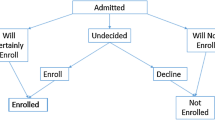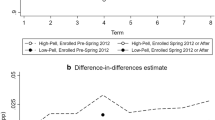Abstract
In this study, I capitalize on a natural experiment to examine the effect of federal Pell Grant eligibility on college enrollment for students who graduated from high school in spring 2004 and who completed the Free Application for Federal Student Aid (FAFSA). Data from the Education Longitudinal Study of 2002 are used to array students on the continuous Expected Family Contribution (EFC) variable, attained from the FAFSA, and divide them into two categories—those with an EFC at or below the federally designated amount for Pell eligibility, and those above. This regression-discontinuity approach allows me to measure whether students who vary regarding their Pell Grant eligibility, but who have essentially identical family incomes, differ in their college enrollment rates. I find no effect. While confirming prior studies examining the impact of the Pell Grant on college enrollment for traditional students, this finding remains inconsistent with findings on other need-based grants. This result suggests that the minimum Pell Grant amount, currently less than 10% of an average college’s tuition and fees, may be insufficient.
Similar content being viewed by others
References
Abraham, K., & Clark, M. (2006). Financial aid and students’ college decisions evidence from the District of Columbia Tuition Assistance Grant Program. Journal of Human Resources, 41(3), 578–610.
Baum, S., & Ma, J. (2007). Education pays: The benefits of higher education for individuals and society. Washington, DC: The College Board.
Becker, G. S. (1993). Human capital: A theoretical and empirical analysis, with special reference to education. Chicago: University of Chicago Press.
Berkner, L. K., Cuccaro-Alamin, S., & McCormick, A. C. (1996). Descriptive summary of 1989–90 beginning postsecondary students 5 years later: With an essay on postsecondary persistence and attainment (NCES 96–155). U.S. Department of Education, National Center for Education Statistics. Washington, DC: U.S. Government Printing Office.
Berkner, L. K., He, S., & Cataldi, E. F. (2002). Descriptive summary of 1995–96 beginning postsecondary students six years later (NCES 2003–151). U.S. Department of Education, National Center for Education Statistics. Washington, DC: U.S. Government Printing Office.
Bettinger, E. (2004). How financial aid affects persistence. In C. Hoxby (Ed.), College choices: The economics of where to go, when to go, how to pay for it. Chicago, IL: University of Chicago Press.
Bettinger, E., Long, B. T., & Oreopoulos, P. (2004). The role of perceptions and information in college access: An exploratory review of the literature and possible data sources. Boston, MA: The Education Resources Institute (TERI).
Carroll, C. D. (1989). College persistence and degree attainment for 1980 high school graduates: Hazards for transfers, stopouts, and part-timers (NCES 89–302). U.S. Department of Education, National Center for Education Statistics. Washington, DC: U.S. Government Printing Office.
College Board. (2009). Retrieved August 2, 2009, from http://www.collegeboard.com/student/pay/scholarships-and-aid/36318.html.
Department of Education. (2009). Retrieved August 2, 2009, from http://www2.ed.gov/programs/fpg/index.html.
Draut, T. (2009). Debt-for-Diploma System: Student-loan debt saddles college grads long after they earn degrees. New England Journal of Higher Education, 23(3), 31–32.
Dynarski, S. M. (2003). Does aid matter? Measuring the effect of student aid on college attendance and completion. American Economic Review, 93(1), 279–288.
Dynarski, S. M. (2004). Who benefits from the education saving incentives? Income, educational expectations and the value of the 529 and Coverdell. National Tax Journal, 57(2), 359–383.
Dynarski, S. M., & Scott-Clayton, J. E. (2007). College grants on a postcard: A proposal for simple and predictable federal student aid. Washington, DC: The Brookings Institution, The Hamilton Project.
Ehrenberg, R. G., & Sherman, D. R. (1984). Optimal financial aid policies for a selective university. Journal of Human Resources, 19(2), 202–230.
Ellwood, D. T., & Kane, T. J. (2000). Who is getting a college education? Family background and the growing gaps in enrollment. In S. Danziger & J. Waldfogel (Eds.), Securing the future (pp. 283–324). New York: Russell Sage Foundation.
Hansen, W. L. (1983). The impact of student financial aid on access. In J. Froomkin (Ed.), The crisis in higher education. New York, NY: Academy of Political Science.
Heller, D. E. (2008). Financial aid and admission: Tuition discounting, merit aid, and need-aware admission. Arlington, VA: National Association for College Admission Advising.
Horn, L. J. (1996). Nontraditional undergraduates: Trends in enrollment from 1986 to 1992 and persistence and attainment among 1989–90 beginning postsecondary students (NCES 97-578). U.S. Department of Education, National Center for Education Statistics. Washington, DC: U.S. Government Printing Office.
Kane, T. J. (1995). Rising public college tuition and college entry: How well do public subsidies promote access to college? National Bureau of Economic Research. NBER-No. 5164.
Kane, T. J. (1999). The price of admission: Rethinking how Americans pay for college. Washington, DC: The Brookings Institution Press.
Kane, T. J. (2003). A quasi-experimental estimate of the impact of financial aid on college-going. NBER Working Paper 9703.
Lesik, S. A. (2007). Do developmental mathematics programs have a causal impact on student retention? An application of discrete-time survival and regressiondiscontinuity analysis. Research in Higher Education, 48(5), 583–608.
Leslie, L. L., & Brinkman, P. T. (1987). Student price response in higher education. Journal of Higher Education, 58(2), 181–204.
Leslie, L. L., & Brinkman, P. T. (1988). The economic value of higher education. New York: Oryx Press.
McPherson, M. S., & Schapiro, M. O. (1991). Keeping college affordable: Government and educational opportunity. Washington, DC: The Brookings Institution.
McPherson, M. S., & Shapiro, M. O. (1999). The student aid game: Meeting need and rewarding talent in American higher education. Princeton, NJ: Princeton University Press.
Murnane, R. J., & Willett, J. B. (2010). Methods matter: Improving causal inference in educational and social science research. New York, NY: Oxford University Press.
Perna, L. W., Rowan-Kenyon, H., Bell, A., Thomas, S. L., & Chunyan, L. (2008). A typology of federal and state programs designed to promote college enrollment. Journal of Higher Education, 79(3), 243–267.
Roderick, M., Nagaoka, J., Coca, V., Moeller, E., Roddie, K., Gilliam, J., & Patton, D. (2008). From high school to the future: Potholes on the road to college. Consortium on Chicago School Research, University of Chicago.
Seftor, N., & Turner, S. (2002). Back to school: Federal student aid policy and adult college enrollment. Journal of Human Resources, 37(2), 336–352.
Shadish, W. R., Cook, T. D., & Campbell, D. T. (2002). Experimental and quasi-experimental design for generalized causal inference. Boston: Houghton-Mifflin.
Singer, J. D., & Willett, J. B. (2003). Applied longitudinal data analysis: Modeling change and event occurrence. New York, NY: Oxford University Press.
Thistlethwaite, D. L., & Campbell, D. T. (1960). Regression-discontinuity analysis: An alternative to the ex post facto experiment. The Journal of Education Psychology, 51(6), 309–317.
U.S. Department of Education. (2009). Retrieved October 4, 2009, from www.ed.gov/programs/fpg/index.html.
Van der Klaauw, W. (1997). A regression discontinuity evaluation of the effects of financial aid offers on college enrollment. C.V. Starr Center Research Report 97–10, New York University.
Acknowledgments
The original collection of the ELS-2002 data was funded by the National Center for Educational Statistics, U.S. Department of Education. This secondary analysis was funded by a Harvard University Presidential Fellowship. I thank Bridget Terry Long, Richard Murnane, and John B. Willett for their valuable insights and methodological guidance. I also thank Lynne Sacks, Rachel Slama, and Monica Yudron for their feedback on earlier versions of this article.
Author information
Authors and Affiliations
Corresponding author
Rights and permissions
About this article
Cite this article
Rubin, R.B. The Pell and the Poor: A Regression-Discontinuity Analysis of On-Time College Enrollment. Res High Educ 52, 675–692 (2011). https://doi.org/10.1007/s11162-011-9215-6
Received:
Published:
Issue Date:
DOI: https://doi.org/10.1007/s11162-011-9215-6




